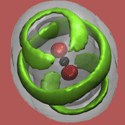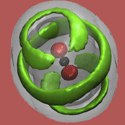Microscopic superfluidity
The familiar “macroscopic” superfluid is a bath of helium- cooled below a temperature of kelvin. Experiments have suggested that the smallest cluster exhibiting superfluidity would be eight helium atoms, but the possibility that this phenomenon could occur in smaller clusters, made not of helium, but of other light, bosonic molecules, has been actively pursued.
In a paper appearing in Physical Review Letters, Hui Li, Robert Le Roy, and Pierre-Nicholas Roy at the University of Waterloo and Robert McKellar at the National Research Council in Ottawa, both in Canada, report experiments, backed by simulations, suggesting superfluidity can occur in clusters of zero spin (para) hydrogen molecules containing as few as nine molecules.
The standard way of measuring the onset of the superfluid transition is to rotate a disk in a bath of the liquid as it is cooled. Below the transition, the fraction of superfluid liquid grows, exerting less drag on the disk, which in turn appears to have a lower effective moment of inertia.
To measure superfluidity in a droplet or cluster, however, experimentalists must embed it with a very tiny rotating element: a single molecule. Using infrared spectroscopy, Li et al. measured the absorption lines associated with the natural rotation of a molecule in para-hydrogen clusters, containing between and molecules. They then used these measurements as input for simulations to calculate the effective rotational inertia of the hydrogen clusters at subkelvin temperatures. In a classical liquid, a hydrogen cluster’s rotational inertia should increase as the cluster grows in size, but the Canadian team finds this trend reverses in clusters with nine or more hydrogen molecules, indicating that clusters of this size are in the superfluid state. – Jessica Thomas





